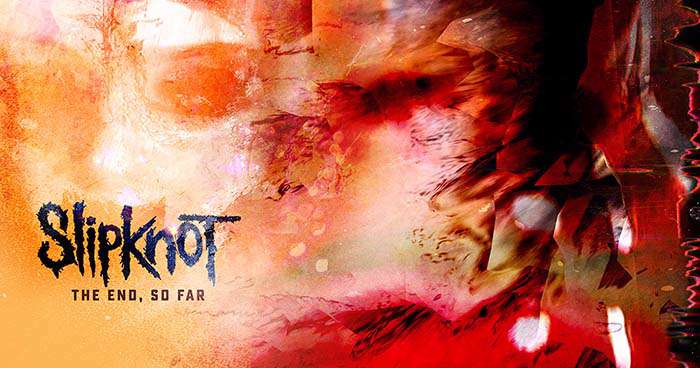No act from the late ‘90s Nu Metal explosion has maintained relevance like Des Moines, Iowa’s Slipknot. Throughout their career, the group established a potent musical identity of hard-hitting down-tuned riffs, frenetic drumming and brutal roared vocals accentuated by moody keyboards, turntable scratches and auxiliary percussion. Notably, the band also boasts a unique visual identity with each of its nine members donning his own custom horror-inspired mask. While the Iowa Nine’s early records were primarily informed by the thrash and death metal of the ‘90s, 2004’s “Vol. 3: The Subliminal Verses” saw the band moving toward a more pop-rock-tinged, radio-friendly sound. As the band’s commercial appeal grew, many devoted fans continued to demand a return to their older thrash-inspired musical style. Almost 20 years later, this conversation still surrounds each album release cycle, and this year’s “The End, So Far” is no exception.
Even before the album’s official release, many fans were skeptical about this new helping of Slipknot. Reception to the released singles was middling at best, and even band members expressed misgivings about the creative and production process.
“I didn’t have a lot of creative input,” guitarist Jim Root said in an interview with MusicRadar. “[Percussionist and bandleader Shawn Crahan] was like, ‘It’s not a record! It’s not a Slipknot record!”
Considering these factors, it is not surprising that the record ended up being a less-than-stellar addition to the Slipknot catalog.
“The End, So Far” begins in an interesting fashion with the opening track “Adderall,” a mid-tempo ballad that mixes pianos, atmospheric keyboards, guitar feedback and a pleasant bouncing bassline. This opener is a far cry from the aggression that characterizes the band’s usual releases. ”Adderall,” while undeniably a bold inclusion, fails to leave any lasting impression–especially compared to the punchy, memorable tracks that make up much of the band’s catalog. The following two tracks crank up the heat, bringing frontman Corey Taylor’s roar and drummer Jay Weinberg’s intricate double-kick action back to the fore for more classic Slipknot fare. The latter of the two, “Chapeltown Rag,” contains glints of the raw, in-your-face potency of the band’s early material, particularly in the track’s closing moments as Taylor screams “When everything is God online, nothing is.” It is abundantly clear that “Iowa”-era Slipknot is not completely lost to time.
“Hive Mind” is a continuation of regular Slipknot programming in what I consider to be one of the album’s standout tracks. Employing both clean and harsh vocals, “Hive Mind” features one of Taylor’s finest performances on the record. The chorus, while not totally unlike the metalcore-esque singalong hooks that weigh down much of the album’s tracklist, is concise, catchy and crucially, is not repeated ad nauseam. With intricate, varied guitar work and atmospheric synths, “Hive Mind” combines cleaner, more accessible production with a sound that is authentically Slipknot.
“Medicine for the Dead” is,by all means, solid, but it suffers from the pitfalls of protracted songwriting that many tracks from the band’s previous record suffered. With the song’s synth and clean guitar intro, “Medicine” almost seems like a bad impression of Tool, but with none of the rhythmic, lyrical and musical elements that keep Tool’s winding compositions interesting. Nevertheless, the music itself retains elements of Slipknot brilliance, and with a bit of pruning, the track could have been a mainstay on setlists.
“Acidic” is one of the album’s true low points. The track slows down to a trotting tempo for five minutes of insipid grunge-like howls and forgettable pentatonic guitar noodling. The composition in many ways echoes the problems of “Medicine” as “Acidic” drags on without interesting musical elements to hold the listener’s attention. By the song’s three-minute mark, the track has already worn off its welcome. The group picks up the quality for “H377,” perhaps the most compelling track on the album. With all the classic Slipknot elements–a low-end-heavy assault of guitars and drums topped with powerful roars–“H377,” more than perhaps any other song on the album, demonstrates what makes Slipknot stand out from its peers.
Unfortunately, the album ends with a whimper rather than a bang with “Finale.” Rather than playing to their strengths with a hard-hitting and memorable closer, the band opts to end the album with another synth-ridden ballad akin to “Adderall.” While lacking the classic heavy sound, “Finale” also fails to provide the emotional effect necessary for an effective metal power ballad.
While the band has clearly demonstrated a desire to break free from the stylistic confines of their earlier material, Slipknot fails to show an ability to write compelling tunes outside of the heavy metal genre. Though “The End, So Far” exhibits occasional sparks of hope, Slipknot ultimately delivers an incohesive grab-bag of songs far inferior to the more focused efforts of their earlier years.








BlackRayPlayer • Oct 12, 2022 at 7:56 am CDT
I’m done with this artist. Corey Taylor telling fans “Shut the f*** up and listen to what we give you!” to those that do not like the album yet they cannot stomach the older tracks themselves. Bunch of panzy ass hypocrites if you ask me. They bitch and complain about the older tracks, and even some of the band members feel they don’t like the new album and wished they had more time. What a stupid ignorant band, unaccepting that some like it, some do not.
Nate • Oct 9, 2022 at 12:24 am CDT
What a half assed review. Actually one of their better albums with more dynamics.